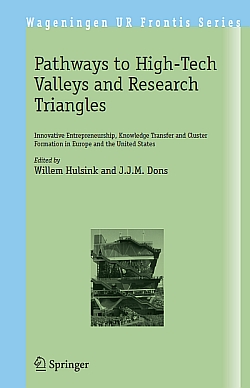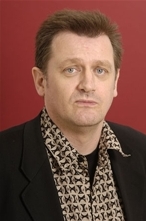Pathways to High-Tech Valleys and Research Triangles
Innovative Entrepreneurship, Knowledge Transfer and Cluster Formation in Europe and the United States
By <link people wim-hulsink _blank>Willem Hulsink and Hans Dons (Eds.)
 Silicon Valley and the industrial districts of Italy, where shared identity, superior skills, regional specialization and trust-based networking among local firms have produced dynamic and flexible ecosystems, are inspiring examples of the successful promotion of thriving technology and business clusters. Cluster studies, besides acknowledging (the potential of) concentration and spill-overs in a dynamic network of larger companies and new start-up firms, also pay attention to the importance of investors, universities and other supportive institutions that contribute to the international and longer-term competitiveness of local industry clusters.
Silicon Valley and the industrial districts of Italy, where shared identity, superior skills, regional specialization and trust-based networking among local firms have produced dynamic and flexible ecosystems, are inspiring examples of the successful promotion of thriving technology and business clusters. Cluster studies, besides acknowledging (the potential of) concentration and spill-overs in a dynamic network of larger companies and new start-up firms, also pay attention to the importance of investors, universities and other supportive institutions that contribute to the international and longer-term competitiveness of local industry clusters.
This book looks at why certain regions are successful in creating an innovative technology cluster (with chapters on Silicon Valley and the Italian Food districts) and why aspiring communities and districts seek to learn from those examples and create an internationally successful region or sector (with chapters on the Dutch Biopartner program to stimulate entrepreneurship in the life sciences, on high-tech Israel and on the Italian Slow Food Movement). In some cases internationally renowned universities and/or research laboratories inspire engineers and scientists to become entrepreneurs and take the lead in cluster development (e.g. in the chapters on Food Valley Wageningen, the Knowledge Pearl Leuven-Flanders and the Scandinavian Oresund cluster). In other cases indigenous flagship firms, collaborating with each other and outsourcing many activities to smaller companies, may act as a region’s catalyst (e.g. in the chapters on Flanders Vegetable Valley, the Dutch horticultural industry and the Defence Diversification Agency in the UK). Chapters on North Carolina’s Research Triangle Park and the recent initiative to stimulate innovativeness in East Netherlands show that also an active government can stimulate emerging clusters by making local resources and funds available (e.g. risk capital, high-quality infrastructure), attracting foreign firms to invest and building ties between the private sector, knowledge institutions and local authorities.

Willem Hulsink
Table of contents
Preface
1. Venturing and clustering in agri-food and high-technology hot spots: introduction; W. Hulsink and H. Dons.
High-tech clusters in the United States and Europe
2. North Carolina's Research Triangle Park: overview, history, success factors and lessons learned; J.W. Hardin.
3. Clustering in ICT: from Route 128 to Silicon Valley, from DEC to Google, from hardware to content; W. Hulsink, D. Manuel and H. Bouwman.
4. A hotbed for entrepreneurship and innovation: looking for success factors in Israel's High-Tech Clusters; U. de Haan.
5. Creating the dynamic technology region: the knowledge pearl Leuven – Flanders; M. Hinoul.
The importance of innovation, entrepreneurship and knowledge transfer
6. Innovation and knowledge transfer in the Dutch horticultural system; H. Dons and R.J. Bino.
7. A demand-led, network-based approach to technology transfer: the experience of the UK Defence Diversification Agency: J. Molas-Gallart and D. McDonnell.
8. Stimulating entrepreneurship in life sciences: the Dutch approach; H. Hu and W. Mosmuller.-
Agri-food clusters and communities in Europe
9. Structural changes and the role of districts in the development of the Italian food industry; C. Brasili and R. Fanfani.
10. Food innovation at interfaces: experience from the Öresund region; M. Lagnevik.
11. The emergence of slow food: social entrepreneurship, local foods and the Piedmont gastronomy cluster; H.S. van der Meulen.
12. The Flemish frozen-vegetable industry as an example of cluster analysis: Flanders Vegetable Valley; W. Vanhaverbeke, J. Larosse and W. Winnen.
Stimulating innovation, entrepreneurship and regional clustering in the East Netherlands
13. East Netherlands as an innovation region: can a triangle between valleys compensate for low critical mass?; P. Tindemans.
14. From 'Wageningen City of Life Sciences' to 'Food Valley'; C. Crombach, J. Koene and W. Heijman
More Information
- Homepage of the Book
- <link people wim-hulsink _blank>Personal Homepage Willem Hulsink


